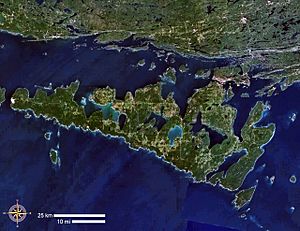Manitou facts for kids
Manitou is a special spiritual power or "life force" that many Algonquian groups believe in. It's like the energy that connects everything in the world. You can find Manitou everywhere: in living things, in nature, and even in events that happen.
Some people use the term Aashaa monetoo to mean a "good spirit." On the other hand, otshee monetoo means a "bad spirit." In some stories, the Great Spirit, called Aasha Monetoo, created the world. This Great Spirit then gave the land to the indigenous peoples, especially the Shawnee.
What is Manitou?
The idea of manitou was already very common when Europeans first arrived in North America. In 1585, a person named Thomas Harriot wrote down some words from an Algonquian language called Roanoke. He included the word mantóac, which meant "gods" (plural). You can find similar words in almost all Algonquian languages.
In some Algonquian traditions, Gitche Manitou means a "great spirit" or a supreme being. This idea of a "great spirit" existed long before Europeans came. After Europeans arrived, some Anishinaabe Christian groups, like the Ojibwe, started using Gitche Manitou to refer to God.
Algonquian religions also have medicine men. These healers used their connection to Manitou to see the future, change the weather, and heal sick people. Ojibwe medicine men, for example, mainly focused on healing. They believed that illnesses were caused by magic and spirits. To talk with spirits and use Manitou, a healer would go into a special state, often by singing, dancing, or listening to drum beats.
People who were not healers could also connect with spirits. They would go on a "vision quest." This involved prayer, fasting, or spending time alone away from others. During a vision quest, a person might be visited by an animal, a voice, or an object. This would then become their special guardian spirit.
Manitou in Place Names

The word "Manitou" is part of the names of several places in North America. For example, Lake Manitoba got its name from the area called manitou-wapow. This means "strait of the Manitou" in Cree or Ojibwe. It refers to the strange sound of waves hitting rocks near the narrow part of the lake.
Manitoba is also home to Whiteshell Provincial Park. Here, you can find petroforms, which are symbols made from rocks. These petroforms remind people of the instructions given to the Anishinaabe by the Creator. The Anishinaabe Midewiwin, or Grand Medicine Society, believes this area is Manito Ahbee. This means "the place where the Creator sits." It is said to be the place where the first Anishinaabe person came down from the sky to the ground.
Manitoulin Island is another important place. The Odawa people call it mnidoo mnis, which means "island of the Great Spirit." This island is very important to the Ojibwe, or Anishinaabe, people. It has many sacred sites and special "sounding rocks." Native peoples continue to live on the island, which has several reserves.
In Michigan, along the eastern coast of Lake Michigan, you'll find Sleeping Bear Dunes National Lakeshore. This area includes two islands known as North and South Manitou Islands.
See also
 In Spanish: Manitu para niños
In Spanish: Manitu para niños



